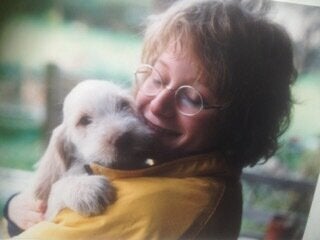We bought a puppy, the most adorable puppy. We named her Gemma and took her home, discovering she was carsick along the way.
Lots of puppies get carsick. But she also cried and howled. The only way to keep her from trying to escape through the closed windows was to hold her on my lap.
While she loved us (and we loved her!), she was terrified of many things: garden gnomes, statues, and umbrellas. She cowered and tried to flee when strangers approached her. She ran away from the vacuum cleaner. She barked at the hair dryer.

This wasn't a puppy-farmed dog, or a rescue or an abuse case. Her breeder told us there was nothing wrong with her at all. It was me. I was making the puppy nervous and "sending signals down the leash."
But I rarely had time to "send signals." I was too busy holding onto Gemma as she fled from London joggers, from anyone wearing a hat, and (ironically) from the plastic Golden Retriever that serves as a collection box for the Guide Dogs. Especially that.
When people came to the house, she backed away, barking furiously. She didn't look like a cute puppy then, but a dangerous, terrified animal.
Training class was impossible. She was too scared to walk into the village hall. I carried her over the threshold. The trainer made the same "you are making her nervous" remark the breeder had, and then slipped a choke chain over her head. He tried to peel her from my lap. My adorable puppy started growling.
I felt a total failure. Gemma was getting worse; it was only a matter of time before she was biting.
This was 1992, pre-internet, but I came across an ad in the back of a dog magazine for a woman whose profession I'd never heard of. She was an animal behaviourist. Was that a kind of doggy shrink? I rang her in desperation and explained the problem.
"How old is the puppy?" the behaviourist asked.
"Only eighteen weeks," I said. "Still very young!"
"That's not so young. When you can get here?"
I bundled Gemma into the car and drove three hours north, during which she cried and shook and destroyed the car's interior.
I spent many days at the centre and many months learning about desensitisation, habituation, "operant conditioning", and "backward chaining."
I stopped forcing Gemma to confront "scary" objects but approached and retreated before she became frightened. I taught my friends to hold out treats, not to make direct eye contact with her, to let Gemma come in her own time.
I did not use a choke chain or give "corrections." I rewarded behaviour I wanted and ignored that which I did not. It sounds so easy, but it wasn't.
I'd imagined I knew something about dogs--after all, I'd grown up with dogs--but it turned out I knew almost nothing. The first step in rehabilitating Gemma had been to admit as much.
Slowly, Gemma grew in confidence. In years to come, she came to be as friendly and well adjusted as any other dog. Well, almost. Every so often, she'd cower in front of a stone garden ornament, crawling on her belly as though trying to avoid enemy fire, and we would remember she had once been a nervous puppy.
I've been thinking about Gemma today as I sit among dog behaviourists at the Centre Of Applied Pet Ethology (COAPE), an organisation headed by internationally recognised dog experts. This time, however, I am not a desperate client seeking help, but a student of the science that saved my puppy. I am studying to be a certified pet behaviourist.

Things have advanced even since my days with Gemma. I've learned that there is no "dominance" hierarchy in dogs. When you hear popular dog trainers talk about dog dominancy, they are referring to a system of beliefs about dogs without much science to support it.
According to the experts at COAPE, dogs derived from wolves that broke away from the wild and began living in villages, scavenging human food and waste. Their loose social order has no fixed dominance hierarchy; they are not competing with me (or anyone else) to be alpha. There is no alpha.
But what about Darwin and evolution and survival of the fittest? It's true that the proliferation of genes was key to the survival of Canis familiaris, or the modern dog, but it turns out the best way to spread genes isn't by forming a pack and competing for position of "top dog".
Possibly the weirdest thing I've learned today is how quickly significant changes in behaviour and appearance can evolve. Careful breeding of wild foxes created an animal that resembled a dog in temperament and looks in just ten years.
If they hadn't shown me the slides, I'd never have believed it.
Once again, I thought I knew about dogs, but Day One at the Centre Of Applied Pet Ethology has blown away most of what I believed to be true about them.
Frankly, I can't wait for Day Two.